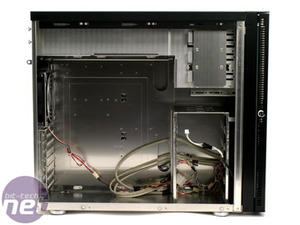
On the outside, looking in
There’s more to reviewing the inside of a case’s design than just looking it over and deciding whether you like it or not, y’know. There’s all manner of little things we look for at each and every stage of the review, things which aren’t always mentioned because people take them for granted but which are still very important.Screws, for instance. You don’t need us to tell you that a case comes with all the right stand-offs and screws – you expect that of a case you’ve paid for. We’d only need to tell you if the case didn’t come with the right screws.
Thankfully, the B25 did come with all the right bits and pieces, but the various screws and thumbscrews which hold the case together did annoy us in another way entirely – they were all screwed in so tightly that it took a serious amount of straining to get them off. Even when they are taken off the side panels are stuck on so securely the it requires a fair amount of muscle in order to shift them.
Depending on your priorities, this can either be a good or a bad thing. If you want a PC which is definitely not going to rattle or fall apart, then a sturdy and tight fitting construction is just what you want. If you’re going to be opening your PC up every other day and tinkering with the set-up though, then you’ll probably want to be aware that the side panels can be more than just a little stiff.
Either way, looking at the inside of the case reveals what I’m told by the rest of the bit-tech team is “the mostly usual” Lian-Li set-up. Mostly usual because the design has apparently been essentially the same for a number of years, but there a few tweaks added on. I’ll assume that you, like me, are unfamiliar with the standard Lian-Li design though and walk you through all the important stuff whether it’s new or old.
For starters, the motherboard tray. Not exactly a tray, it’s more of a panel which can be completely removed once the right hand panel has been taken off, but either way it makes the process of installing a motherboard a lot easier if you don’t have a long-handled screwdriver at hand. The motherboard panel also comes with gaps on the right hand side so that cables can be routed around easily.
If that weren’t enough, there’s also large clips on the back of the panel which can be used to clamp down some of the more ambitious wires and cables.
For cooling the B25 has three fans – one in the back and two in front of the HDD cage, which we’ll get to in a minute. All three fans measure in at 120mm for some great cooling potential, but the fronts are limited to 25mm depth. In a stroke of genius which harks back to the Antec P180, there’s also venting around the edge of the door which lets air in even though the door is closed.
Lian-Li has decided to go without ventilation grilles in the bottom of the case though, which is supported by rubberised feet, probably because of fears that the fans would suck in carpet hairs.
So, next comes the HDD cage, which is unusual to say the least and, I’m told, where a lot of the changes have been made to the standard Lian-Li design.
What makes the design so unusual is that instead of the usual process of screwing your hard drive into a rubberised tray and then sliding the tray into the cage from the left hand side, you have to put the rubber grommets on the screws yourself and then screw the rubberised screws straight into the drive. There’s no tray at all. When you’ve done all this you have to carefully manoeuvre the drive into place through the right-hand side of the case, as it won’t fit in from the left.
The rubber grommets should slot on to a simple rail system there. Simple, supposedly.
I’ve no idea why Lian-Li has chosen to change the design of the HDD cage to this as, to my mind, it doesn’t provide any particular benefits and only makes the process of mounting a hard drive slower and more complicated – it took two of us more than twenty minutes to successfully mount a hard drive and still longer to explain it to everyone else.
The only reason we can explain it so simply to you now is because of the sheer amount of practice we’ve had.

MSI MPG Velox 100R Chassis Review
October 14 2021 | 15:04












Want to comment? Please log in.